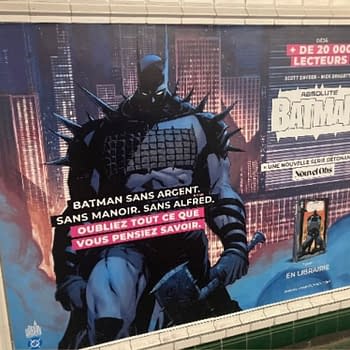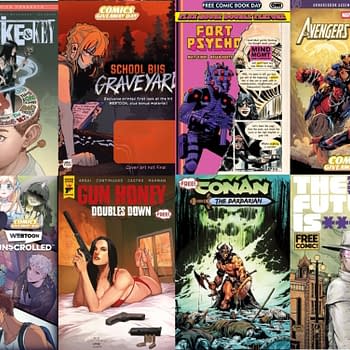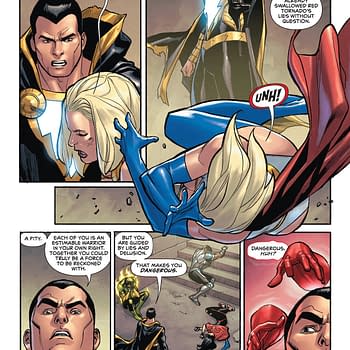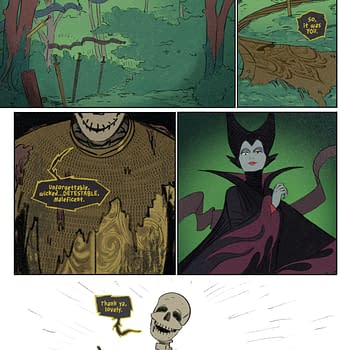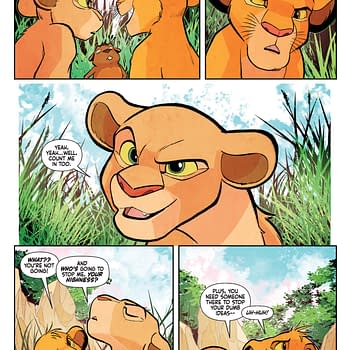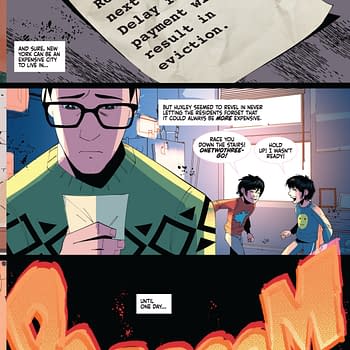Posted in: Comics | Tagged: Comics, image, spawn, todd mcfarlane
Talking To Todd Mcfarlane About…. Stuff
Ian Melton writes;
Ask a comic book fan about Todd McFarlane and they'll probably tell you one of three things: he draws a great Spider-Man; he created Spawn; he has a huge ego. Go further down the list and other things will pop up, but few people know that Todd McFarlane, born in Canada, actually attended college in the U.S. while beginning his push to become a comic artist. Now naming those colleges might be harder for most, but they are both located in Washington state near each other: Spokane Community College and Eastern Washington University, and it was E.W.U on June 15th that asked McFarlane to give a commencement address at his alma mater. The real action though for comic book fans was a rare public speaking event that E.W.U. held the night before, giving McFarlane a chance to tell his own story in his own words.
Titled "Road Trip to Creative Autonomy: An Evening with Todd McFarlane" the event was held in a Red Lion hotel Ballroom in Spokane, Washington and was set to have up to 400 people able to attend. The event was set to be from 7 to 8 with an 8 to 8:30 autograph session, and a limit of 1 to 2 items at most being able to be signed by McFarlane. Taking the stage with quick wit and humor, McFarlane threw the time limit out the window in his first 2 minutes saying he would be going to speak till at least 8:30 P.M. then a Q & A, and then signing stuff "till they throw us out".
McFarlane preceded to tell his life story in a unique way that most comic book creators, even famous ones, will probably never get to do: to a room full of mainly non-comic book fans, in an event set up by a "university", and not with a moderator or the words 'comic-con' anywhere near the event. (Rather oddly Spokane Comic-Con had been held two weeks before.) McFarlane took this opportunity to tell a wide range of events that he tied loosely around the timeline of his life.
He started with discovering three things in growing up in Canada, an aptitude for drawing, a passion for baseball, and a love of the American comic book. The first key theme McFarlane brought up was perspective, something his drawings had even at a young age. "My teachers would ask me, what is it when they'd look at my drawings. And I'd say 'it's obviously a barn' and they'd shrug and I'd explain 'I drew it while looking down from a tree' and they'd nod and kind of ignore me even while they'd admit it was pretty good." After spending some of his youth in California, where he became a "good" baseball player, his family planned to return to Canada during his high school years where he was given the choice of "be a great baseball player, or be a horrible hockey player. It was really kind of an easy choice." His ability to play baseball got him the opportunity to meet his wife, the batgirl for a rival team, who he convinced his dad , his own baseball coach, to trade him to. "Dad it's my last year. You need to think of the future, so trade me to this other team and get yourself some young studs for next year that will win you a championship, which is what happened! I got traded and I won the championship with this other team and the next year my Dad's team won with the players he traded me for! And the best thing for me was I got to meet and spend time around the wonderful woman who became my wife."
Recalling his past, McFarlane was very animated and comical, enjoying the audience response and leading them to the eventual story of how Baseball lead him to Spokane Community College, and then E.W.U., which in the late 80's, then had a baseball program. During this time McFarlane realized baseball could get him through school, but not a permanent job and that led him to his other passion and the dream of drawing comic books for a living. Citing numerous rejections, which continued even after he was hired by Marvel to do backups for the small book "Coyote" before he was out of school, as a great way to get autographs of comic professionals, McFarlane said rejection was the main rule of being a comic book artist. "Everyone does not like your work, or you. They don't have to. Just one editor has to like you, that's it, and that leads to other editors liking you and so on." Going quickly through his transition to part time comic artist for Marvel, then full time at DC, he spoke of his very brief stint on G.I. Joe A Real American Hero during which he had a huge clash with the writer (who he did not name, but he was very clearly talking about Larry Hama) who he citied as hating his artistic perspective and wanted the book drawn in McFarlane's words "as though the comic book reader was a tribal bushman coming out the jungle to see it for the first time". Moving on from there to the Incredible Hulk, McFarlane used these points to quickly get to his work and the controversy over his work on the Amazing Spider-Man.
While on the Incredible Hulk, McFarlane was able to adhere to a strict monthly deadline and do another book as well, which for a short stint was Detective Comics. As his popularity rose Marvel moved to keep him there, but most of Marvel editors at the time told him "stay away from the Spider-Man offices they are a mess right now!" McFarlane laughed, "never tell any young punk with an attitude don't go there, because he will go there!" During this time, 1988, the Spider-Man offices were in transition with Jim Salicrup replacing Jim Owsley (Christopher Priest) and Tom Defalco now Editor-in-Chief instead of Jim Shooter, and Peter Parker and Mary Jane recently married, and the Spider-Man offices coming off the acclaim of Kraven's Last Hunt a few months earlier, the next big thing for Spider-Man was uncertain. The thing McFarlane commented on about this period was the Spider-Man office was eager to have him, and he expected a Spider-Man book, not "the" Spider-Man book. Taking over The Amazing Spider-Man with #298 and getting to draw the milestone #300, as well as helping to create and develop Venom, were the key points McFarlane said brought him to comic book super –stardom and made living in Spokane while his wife finished school very interesting.
The main problem though for McFarlane on the Amazing Spider-Man was the lack of change in how Spider-Man looked. "If you ask your parents or your grandparents what Spider-Man looks like they will refer back to the work of one really talented artist, John Romita, who defined Spider-Man's look in the 60's and 70's. The Spider-Man you 'd see on lunch boxes that was him, but the problem is that no one had tried to draw him differently since then, and I wasn't interested in being a poor man's John Romita when drawing Spider-Man." Citing a preference for drawing the "spider" in Spider-Man versus the "man" part, McFarlane said he put Spider-Man in poses no man could ever make, not even the most nimble gymnast. He also changed the webbing he said because "before it was just three lines, and then x's over the middle line which looks fine when he's swinging through New York, but if he's aiming it at you it looks horrible." So McFarlane changed the webbing he said, added the webbing back under the armpits for the costume, but his new webbing didn't have a name until he was called in to speak with Tom DeFalco (who had for a long time written the Amazing Spider-Man himself). "The book was becoming Marvel's best selling book, and Defalco would call me in to tell me what I was doing wrong."
While McFarlane's problem with drawing the book he said was trying not to look like John Romita, Marvel's problem was that he wasn't trying to look like John Romita. "And Defalco told me to quit using that 'spaghetti webbing', which gave me a name for it! I just shrugged and told him I'd do as he asked, because kids you never tell someone you aren't going to do something and have an argument. If mom asks if you have cleaned your room, say yes even if you haven't because you could either go have fun, come home, and then have the argument, or have the argument right now and not have any fun! So I told him I'd do the changes even though I had no intention of doing so."
Continuing on Spider-Man the book rose in sales to being on of Marvel's best selling books, despite the continued requests McFarlane said he got to change his art style, and when McFarlane was thinking about a change, they gave him his own Spider-Man book to keep him put, which netted him a Guinness record for highest amount of copies of a comic sold (at the time). This first award led him to relate his other theme for the night that perception is the main thing that makes people think you can do things. "I've won a Grammy, and I don't know a damn thing about music. I've directed two music videos without knowing anything about how to do it. People see awards and they assume you can do things, and that's how I get all these great new opportunities."
Eventually though he had to relate to the audience the story of how in the early 90's Image Comics was formed and he debuted Spawn. For comic book fans this is very common knowledge, but for the non-comic fans something very very foreign. However, McFarlane filled the story with some fun little known personal asides, as he related how he and six other Marvel comic book creators left Marvel to start their own company. "We had a meeting with Marvel and told them we were leaving. I'll never forget two things from that meeting. One, Jim Lee, one of the smartest men I knew said 'I hope we aren't making a mistake' which I had to laugh at. I mean I'm no the smartest guy, but we were going out to put ink to paper, an idiot can do that! But as we left, they told us 'when it fails you guys can come back with no repercussions'. That takes huge ego to assume before we even had left that we were going to fail. Now the funniest part to me was the day after we left Marvel, we arranged a meeting with DC and they were all excited, because they thought 'they just left Marvel, and they are coming here to work for us'! And we went over to specifically tell them 'we aren't going to work for you either' and their jaws dropped." The creation of Image comics was seen as "crazy" at the time according to McFarlane, but it succeeded and continues to succeed.
McFarlane didn't stop there though as he then related his entry into making toys, a market when he started dominated by Toys R' Us in terms of buying. At McFarlane's first Toy Fair he had next to nothing to show, not one fully done "action figure", but the assistant of the buyer for Toys R' Us had talked up McFarlane so much that the buyer walked into the crowded room, made a huge order with McFarlane and then left, giving McFarlane what he needed to get his toy company going. He then related his choice to buy the Mark McGwire home run balls for 3 million dollars which he said was a great PR move that got him over 7 million in contracts and business, making their purchase well worthwhile. After this though McFarlane noticed his speaking was getting close to over 8:30 and he still had promised a Q & A so he wrapped up while over 60% of the audience got up to form a line for autographs that the staff of the event was unprepared for.
Taking questions while many got in line, McFarlane was asked about when Spawn would be coming back to theaters. Playing up Spawn's box office money from the first movie and the current buzz for comic book movies, McFarlane said he has an Academy Award winning actor ready for the movie and wants to do a mafia movie where a supernatural creature shows up in the middle of it as the basic premise. He also says he won't sign off on the movie for any studio unless he gets to write, direct, and produce it, and that when he tells most Hollywood types that, and that Spawn probably won't speak during the whole movie, most don't call back. The question actor followed up with a hope for Spawn to return to animation, and to see what would have happened with Angela, but McFarlane avoided the Angela idea quickly by moving to the next question.
Another question was about the creative decision to change who Spawn was, instead of Al Simmons to the current Jim Downing, which McFarlane said he did mainly to make the book fresh again and give him a main character he could write who could interact with the same universe but in a new way. "There are only so many times I can have Spawn fight Violator without it seeming old." He then related how he got the name Violater, stating he got it from a sign up in Canada which stated "Violators will be towed". He also answered a very simple question about how Todd's Toys became McFarlane Toys by explaining "you know Barbie right? And you've heard of Ken? Well Ken has a friend named Todd so Mattel thought my toys could be confused for their character 'Todd' and sent a cease and desist so I just changed the name to avoid the headache, and I think the name is a better choice anyway."
The last two questions of the night led McFarlane to speak about being an artist, and how now working in video games he's found you don't have to do it all. "I used to assume when I drew the Spider-Man book I should do it all. I'd write it, draw it, ink it, letter it, and I thought to keep my job I should try to do it all. In video games I've found that if you are good at one part of artwork focus on that, you don't need to be a jack-of-all-trades. I've seen artists hired who can't draw a body to save their life, but they can draw a spell like crazy! We hire artists just to draw spells." He also explained to an upcoming artist what Image Comics was still all about, boiling it down to being a publishing house that no matter how many copies you sell, "we still take out the same about for publishing your book".
Finishing up with questions, McFarlane signed as many items as people had brought though 40% of the crowd left when he finished speaking, leaving the comic book fans to get stuff signed, and a few guests who decided to get the comic book given to the attendants signed. As part of the event, 400 copies of Spawn #232 were produced and given out, with the tagline "Attack of the Eagles' Red Carpet" added to the cover. (Copies of the book are selling for over $100 on eBay, as most fans kept the book, and other attendants didn't know it was rare if they even bothered to take it home at all.) McFarlane signed until after 11:00 PM and closed down the ballroom which was completely cleaned up and restored to normal before his fans had left.
When asked about the experience, one attendant, who had never heard of McFarlane before being asked to tag along, said she found McFarlane to be a very entertaining speaker, charming, funny, and clearly incapable of talking about anything that he didn't want to talk about, avoiding questions about controversial topics in a blunt fashion. "I liked the way he spoke but clearly he has a huge ego…" Most clearly found the event enjoyable, but McFarlane was clearly running the show the way he wanted, and the E.W.U. staff was unprepared for that and how many people would want things signed. McFarlane brought humor and charm to this speaking, but for those who know much about the era he spoke of, he brought a clear and narrow view of how things happened. Though to be fair he started out his presentation with the following warning: "I'm going to talk about my life and despite what some people say, I know it better than anyone because I lived it and I'm going to tell you about it", which is what he did.







